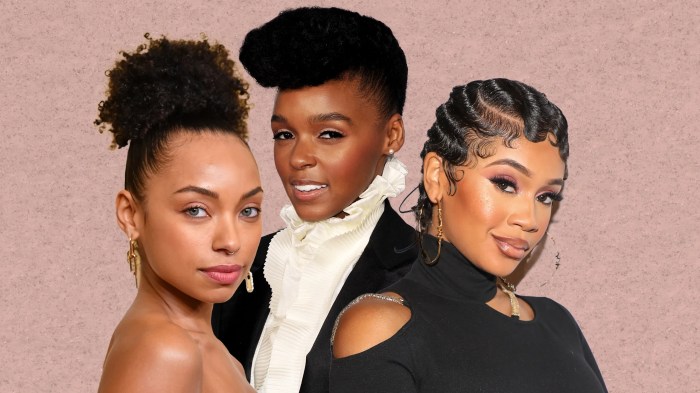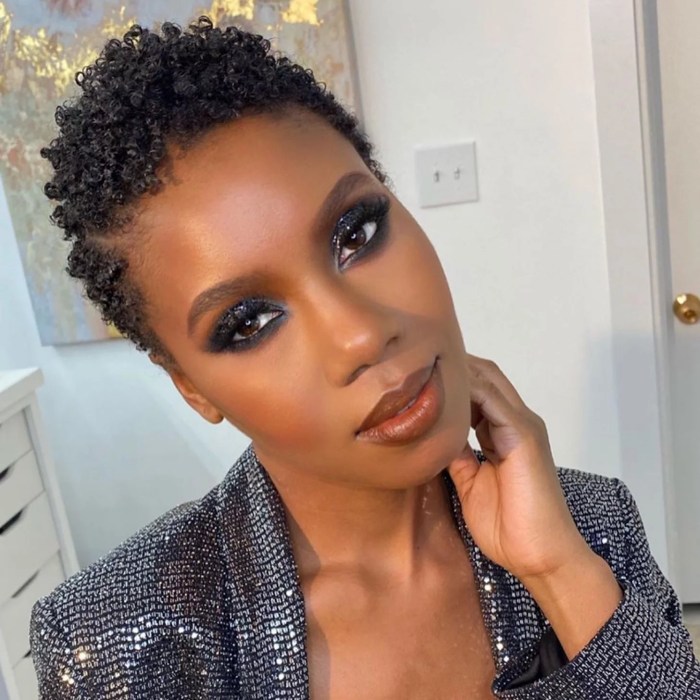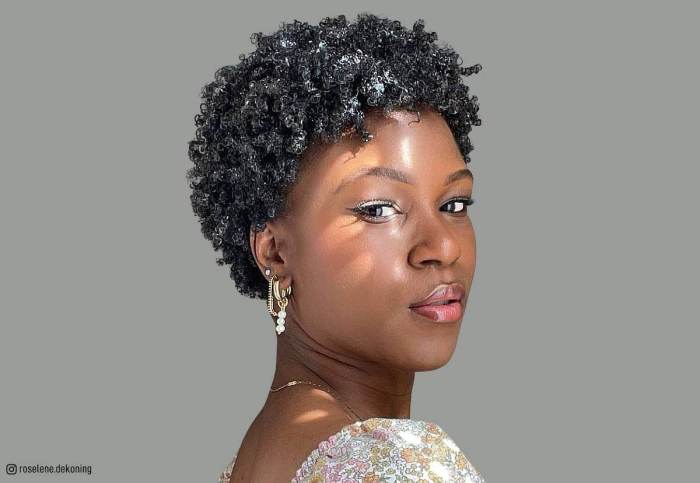Cut Hairstyles for Natural Hair A Comprehensive Guide
Popular Cut Hairstyles for Natural Hair
Cut hairstyles for natural hair – Choosing the right haircut for natural hair can be transformative, enhancing your features and simplifying your styling routine. This section explores popular natural hair cuts categorized by length, their adaptability to different hair textures, and their associated styling needs.
Popular Natural Hair Cuts by Length and Texture
The following table Artikels ten popular hairstyles, considering short, medium, and long hair lengths. Remember that the best style depends on individual hair texture and face shape.
| Hairstyle Name | Description | Hair Length | Image Description |
|---|---|---|---|
| TWA (Teeny Weeny Afro) | A very short, close-cropped cut. | Short | A rounded, close-cropped style showcasing the natural hair texture; it can range from a very neat and precise cut to a slightly more textured and voluminous look depending on styling. |
| Pixie Cut | Short, layered cut with longer pieces on top. | Short | Short, layered cut with longer pieces on top, creating volume and movement. The sides and back are usually very short, offering a sharp contrast to the longer top layers. |
| Tapered Cut | Gradually shorter layers, creating a sleek, defined shape. | Short to Medium | The hair is gradually shorter from the top to the nape of the neck, offering a smooth transition in length and creating a clean, sophisticated look. |
| Shoulder-Length Bob | A classic bob cut that falls around the shoulders. | Medium | A blunt or slightly layered cut that sits at or just below the shoulders, offering a versatile and timeless look. |
| Long Layers | Multiple layers creating movement and volume. | Medium to Long | Several layers of varying lengths, creating a cascading effect that adds dimension and movement to the hair. |
| Afro | A naturally voluminous style with minimal cutting. | Medium to Long | A full, round, voluminous style that embraces the natural texture and curl pattern of the hair. |
| Undercut | Short, shaved sides with longer hair on top. | Medium to Long | A bold style featuring shaved or very short sides and back, with significantly longer hair on top, allowing for a variety of styling options. |
| Curly Lob | A longer bob that accentuates curls and waves. | Medium to Long | A longer version of the bob, specifically designed to enhance the natural curl pattern and create a soft, flowing style. |
| Bantu Knots | Small, coiled sections of hair twisted and secured. | Medium to Long | Many small sections of hair are twisted into knots and secured, creating a unique and protective style. This style is typically worn for a short period and then taken down. |
| Braids (Box Braids, Cornrows, etc.) | Hair is intricately braided. | Long | Hair is divided into sections and braided tightly, creating intricate patterns and a protective style. Variations include box braids, cornrows, and many others. |
These hairstyles can be adapted for various hair textures:
- 4c hair: TWA, Afro, Bantu Knots are excellent choices, emphasizing the natural curl pattern. Long layers might require extra attention to prevent dryness.
- 3b hair: Pixie cuts, long layers, and curly lobs work well, showcasing the defined curls and waves.
- 4a hair: Tapered cuts, shoulder-length bobs, and braids offer versatility and manageability.
- 3c hair: Shoulder-length bobs, curly lobs, and braids provide structure and volume while showcasing the hair’s texture.
- 4b hair: Twists, braids, and protective styles like Bantu knots minimize manipulation and prevent breakage.
Styling needs vary greatly:
- TWA: Minimal styling, perhaps a light gel or oil for shine.
- Pixie Cut: Styling products for texture and hold are beneficial.
- Tapered Cut: Requires minimal maintenance, but edge control products may be needed.
- Shoulder-Length Bob: Can be styled straight, wavy, or curly, requiring appropriate products.
- Long Layers: May need leave-in conditioners, curl creams, and oils for moisture and definition.
- Afro: Requires moisturizing products to prevent dryness and frizz.
- Undercut: Requires regular maintenance for the shorter sides, while the longer top can be styled in various ways.
- Curly Lob: Needs moisturizing products and techniques like diffusing to enhance curls.
- Bantu Knots: Requires styling products for hold and definition, and gentle detangling after removal.
- Braids: Maintenance is minimal once installed, but regular scalp care is important.
Choosing the Right Cut Based on Face Shape

Source: allure.com
Selecting a hairstyle that complements your face shape is crucial for achieving a balanced and flattering look. This section provides guidance on choosing hairstyles based on five common face shapes.
Hairstyle Selection for Different Face Shapes

Source: popsugar-assets.com
| Face Shape | Suitable Hairstyles | Hairstyles to Avoid | Image Description |
|---|---|---|---|
| Oval | Most styles suit oval faces. Long layers, bobs, and even short cuts can look great. | Styles that completely cover the face and lack volume can make the face appear longer. | Long layers add movement and dimension, while bobs offer a classic, balanced look. Even short, textured cuts can enhance the features of an oval face. Avoid styles that are too heavy or straight around the face. |
| Round | Long layers, styles with height on top, and asymmetrical cuts can create length and definition. | Short, blunt cuts that add width around the face. | Long layers create a slimming effect, while height on top balances the roundness. Asymmetrical cuts add angles and visual interest. Avoid short, blunt bobs or styles that lack volume on top. |
| Square | Long layers, side-swept bangs, and styles that soften the jawline. | Short, blunt cuts that emphasize the angles of the face. | Long layers soften the sharp angles, while side-swept bangs draw attention away from the jawline. Styles with soft waves or curls further enhance this effect. Avoid styles that are too blunt or boxy. |
| Heart | Styles that add volume at the bottom and minimize volume at the top. Long layers, side-swept bangs. | Short, blunt cuts that emphasize a wide forehead. Styles that add volume at the top. | Long layers add balance, while side-swept bangs draw attention away from a wide forehead. Styles that add volume to the chin area further enhance this effect. Avoid styles that emphasize the width of the forehead. |
| Diamond | Styles that add volume at the cheekbones and jawline. Shoulder-length styles or bobs. | Styles that emphasize the narrow forehead and chin. | Shoulder-length styles add volume to the cheekbones and jawline, balancing the narrow forehead and chin. Styles with soft waves or curls further enhance this effect. Avoid styles that are too sleek or straight. |
Hair length significantly impacts the overall look for each face shape. For example, longer hair can elongate a round face, while shorter hair can add volume to a diamond face. Experimentation is key to finding the most flattering length and style.
Maintenance and Styling Techniques for Natural Hair: Cut Hairstyles For Natural Hair
Maintaining natural hairstyles requires consistent care and the right techniques. This section details the maintenance and styling of three popular styles.
Maintaining and Styling Three Natural Hairstyles, Cut hairstyles for natural hair
Here’s a step-by-step guide for maintaining a TWA, long layers, and an afro:
- TWA Maintenance:
- Wash weekly with a moisturizing shampoo and conditioner.
- Apply a leave-in conditioner for extra moisture.
- Use a lightweight oil or styling cream for shine and definition.
- Keep edges neat with an edge control product.
TWA Styling Techniques:
- Use a small amount of gel or pomade to create a sleek look.
- Apply a curl cream to enhance natural texture.
- Long Layers Maintenance:
- Wash every 1-2 weeks with a moisturizing shampoo and conditioner.
- Deep condition weekly to prevent dryness.
- Use a leave-in conditioner and styling cream for moisture and definition.
- Consider using a heat protectant if using heat tools.
Long Layers Styling Techniques:
- Use a diffuser to dry hair gently and enhance curls.
- Style with a curling iron or flat iron for a more polished look.
- Use styling products for hold and definition.
- Afro Maintenance:
- Wash every 1-2 weeks with a moisturizing shampoo and conditioner.
- Deep condition weekly or bi-weekly to maintain moisture.
- Use a leave-in conditioner and styling cream to enhance volume and definition.
- Avoid harsh brushing or combing.
Afro Styling Techniques:
- Use a pick or wide-tooth comb to gently detangle and style.
- Apply a curl cream or gel for definition and hold.
- Consider using a diffuser to dry hair and reduce frizz.
Product recommendations include shea butter, coconut oil, and natural hair-friendly styling creams and gels.
Inspiring Natural Hair Transformations
Natural hair transformations can be incredibly inspiring, showcasing the versatility and beauty of natural hair. Here are five examples illustrating the impact of different cuts.
Examples of Natural Hair Transformations
The following examples demonstrate the power of a well-chosen haircut to enhance natural hair.
- Example 1: A client with long, thin 3a hair opted for a shoulder-length bob to add volume and create a more polished look. The transformation involved removing split ends and layering the hair to create movement. A volumizing mousse was used for styling.
- Example 2: A client with thick, dense 4c hair transitioned from long box braids to a short, tapered cut to reduce weight and improve manageability. The transformation emphasized the client’s natural texture and reduced styling time significantly.
- Example 3: A client with medium-length 3b hair wanted to enhance her curls. A curly lob with face-framing layers was chosen to showcase the curl pattern and add volume. A curl cream and diffuser were used to achieve the desired style.
- Example 4: A client with fine 4a hair opted for a pixie cut to add volume and create a modern, edgy look. The transformation involved careful layering to create texture and movement. A lightweight styling gel was used for hold.
- Example 5: A client with long, damaged 3c hair chose long layers to remove split ends and improve overall health. The transformation involved a significant length reduction but resulted in healthier, more manageable hair. A deep conditioner and leave-in conditioner were key to the process.
Each transformation was tailored to the individual’s hair type, texture, and personal style. The process involved careful consultation, precise cutting techniques, and the use of appropriate styling products.
Addressing Common Concerns About Cutting Natural Hair
Cutting natural hair can bring up several concerns. Understanding these issues and implementing preventative measures is essential for healthy hair.
Common Concerns and Solutions for Natural Hair Cuts

Source: latest-hairstyles.com
Here are some common concerns and solutions:
- Shrinkage: Natural hair shrinks when it dries. Understanding this is key to choosing the right length. A stylist specializing in natural hair can account for shrinkage during the cutting process.
- Breakage: Breakage is often caused by dryness, heat damage, or harsh manipulation. Using moisturizing products, avoiding excessive heat styling, and gentle detangling techniques are crucial.
- Dryness: Dryness leads to breakage and makes styling difficult. Deep conditioning treatments, moisturizing products, and limiting heat styling can prevent dryness.
- Uneven texture: Different parts of the hair may have varying textures. A skilled stylist can create a cut that complements these differences.
Consulting a professional stylist specializing in natural hair is crucial. They possess the expertise to address individual hair needs and create a cut that is both stylish and healthy.
Essential Questionnaire
How often should I trim my natural hair?
Trims are recommended every 6-8 weeks to remove split ends and maintain healthy growth. Frequency may vary depending on your hair’s growth rate and texture.
What products should I avoid when styling natural hair?
Avoid products containing sulfates, silicones, and harsh chemicals, as these can strip natural oils and cause dryness and breakage.
How can I prevent breakage when detangling my natural hair?
Use a wide-tooth comb or your fingers to gently detangle hair, starting from the ends and working your way up. Use a leave-in conditioner to minimize friction.
Can I cut my own natural hair at home?
While simple trims are possible at home, for more complex cuts, it’s best to consult a professional stylist experienced with natural hair to avoid mistakes.




















